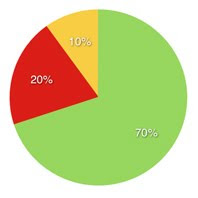 It's almost impossible to classify the recent communication focus surrounding Chrysler. Crisis Communication? Overreaction? PR lesson? Damage control? Best practice? PR disaster? Obscene tweet? Social media failure?
It's almost impossible to classify the recent communication focus surrounding Chrysler. Crisis Communication? Overreaction? PR lesson? Damage control? Best practice? PR disaster? Obscene tweet? Social media failure?Are you kidding me? It's farcical.
All of it. It's especially farcical that less than 140 characters can create a global reaction. But to really appreciate how farcical it is, you need a broader context. The post (that some people have called a best practice) from Chrysler CEO Ed Garsten nails it. (His words in italics).
The hurtful tweet that sparked a firestorm. Oh my.
When a reporter called yesterday snarkily asking, “seen any good tweets lately,” I knew exactly what was coming next -- a firestorm across the web regarding an errant tweet by a now-former employee of Chrysler’s social media agency.
The tweet denigrated drivers in Detroit and used the fully spelled-out F-word. It was obviously meant to be posted on the person’s personal twitter account, and not the Chrysler Brand account where it appeared.
The tweet, reportedly written by Scott Bartosiewicz, account supervisor at New Media Strategies, on Chryslar's Twitter stream, read "I find it ironic that Detroit is known as the #motorcity and yet no one here knows how to fucking drive."
 He worked for the agency for eight months. He's a long-time Michigan resident, maybe a native. He made a mistake. It wasn't even a big mistake.
He worked for the agency for eight months. He's a long-time Michigan resident, maybe a native. He made a mistake. It wasn't even a big mistake. A big mistake might be having to recall 248,000 crossover wagons and minivans or 20,459 Jeep Wranglers. A tiny mistake is saying the wrong thing to 7,000 people who happened to follow Chrysler at the time ... minus spam accounts, minus people who weren't on Twitter, minus people who don't pay attention but follow the brand anyway.
Right. About seven people saw the tweet, including a "snarky reporter" as characterized by Garsten. Hopefully, the reporter is less sensitive than Detroit drivers are toward being "unfairly criticized."
The mean agency fired the guy before they were fired. Oh my.
First, Chrysler did not fire this person since this wasn’t one of our employees. The agency did. It was their decision. We didn’t demand it.
No, Chrysler did not fire the employee. They fired the entire agency. However, some have suggested the change was already top of mind. The errant tweet was just the final straw.
Let's be honest. Had the employee not been fired, he would have been after Chrysler pulled the account.
The sheer horror and anguish of being powerless to stop it. Oh my.
Second, as the day and night wore on, comments on various social media sites increasingly expressed either dismay that someone would lose their job over an online oops and that Chrysler was acting, as one poster put it, “in a stiff, corporate way.” Some posters even asked why we didn’t make light of an accidental “f-bomb."
Exactly right. The mistake didn't cause any sensationalism. It was the initial lie — our account was compromised — that sparked conversation.
You can even see it in the screen shots. The initial tweet wasn't retweeted even after being up for more than three hours. The correction, however, drew immediate attention.
And then, after the firing, the audience for the "incident" swelled from seven people to seven million. And on. And on.
The insensitivity of people for not recognizing all the hard work. Oh my.
So why were we so sensitive? That commercial featuring the Chrysler 200, Eminem and the City of Detroit wasn’t just an act of salesmanship. This company is committed to promoting Detroit and its hard-working people. The reaction to that commercial, the catchphrase “imported from Detroit,” and the overall positive messages it sent has been volcanic.”
 Volcanic? Chrysler is doing better, but it still has a long, long way to go. U.S. sales might have risen 13 percent, but Chrysler Group sales were already up 17 percent in 2010 compared with 2009.
Volcanic? Chrysler is doing better, but it still has a long, long way to go. U.S. sales might have risen 13 percent, but Chrysler Group sales were already up 17 percent in 2010 compared with 2009.But even those numbers don't tell the whole story. You have to appreciate how far sales had to drop before the company could have a gain.
The entire future of the town rests right here. Oh my.
Indeed, as an automaker that went through the roughest of times just two years ago, we appreciate the challenges Detroit faces in reclaiming its place as a vibrant, world-class city. Inside Detroit, citizens are becoming even more proud of their town, and outside the region, perception of Detroit is rapidly improving.
With so much goodwill built up over a very short time, we can’t afford to backslide now and jeopardize this progress.
We need to keep the momentum going -- rebuilding a region and an industry, and not let anything slow us down. It’s what we do.
Is he really saying that 140 characters could somehow undermine the entire economic future of the region and erode all the pride that Detroit citizens have in their town? That's crazy talk. If Detroit is a tough town, one accidental tweet would not undermine their spirit. Heck, even if they did care, hurling a few F-words back at Bartosiewicz would have sufficed.
Suck it up. Unless a crisis is catastrophic (e.g., oil spills and product recalls), the organization establishes the severity of the so-called crisis. This wasn't a crisis. It has, however, become a publicity circus. And honestly, it's not even a very good circus.
The farcical commentaries that suggest tweet "recovery" strategies.
 When you consider what constitutes news, the entire incident can be likened to the :15 second clip of a squirrel on water skiis. It's an oddity that we all might chuckle about it instead of trying to frame it within the context of tragedy.
When you consider what constitutes news, the entire incident can be likened to the :15 second clip of a squirrel on water skiis. It's an oddity that we all might chuckle about it instead of trying to frame it within the context of tragedy.And yet, hundreds of communicators have treated the entire affair like a serious crisis communication case study. The worst of it includes offering up of social media safeguards and running down communication response punch lists. They might as well write a contingency plan for an employee with a hangover. The seriousness of it all just can't be taken seriously.
No one needs a communication strategy for one errant tweet. All anyone needs is common sense. Use common sense and lighten up.
































